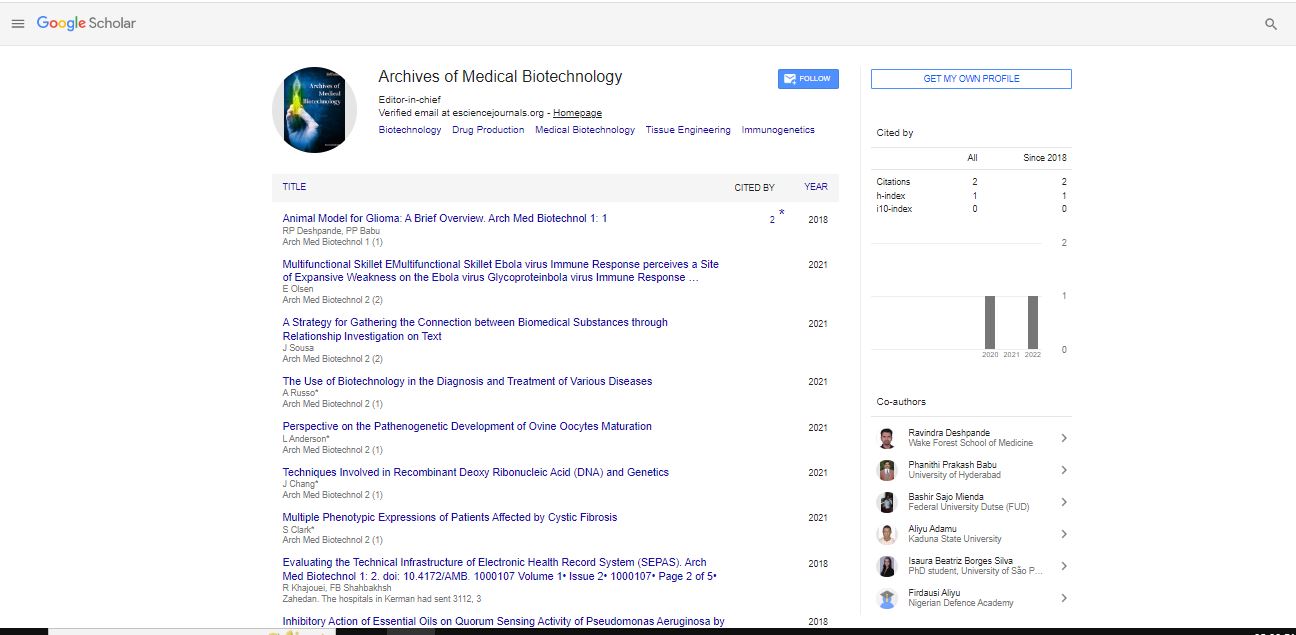Perspective, Tabriz University Of Medical Sciences Vol: 4 Issue: 1
Nanotechnology in Medical Biotechnology: From Diagnosis to Treatment
Amelie Fredrik*
1Department of Medical Biotechnology, Tabriz University of Medical Sciences, Tabriz, Iran
*Corresponding Author: Amelie Fredrik
Department of Medical Biotechnology, Tabriz University of Medical Sciences, Tabriz, Iran
E-mail: fredrikam@tabriz.it
Received date: 14 February, 2023, Manuscript No. AMB-23-95731;
Editor assigned date: 16 February, 2023, PreQC No. AMB-23-95731 (PQ);
Reviewed date: 03 March, 2023, QC No. AMB-23-95731;
Revised date: 10 March, 2023, Manuscript No. AMB-23-95731 (R);
Published date: 20 March, 2023, DOI: 10.4172/amb.1000039.
Citation: Fredrik A (2023) Nanotechnology in Medical Biotechnology: From Diagnosis to Treatment. Arch Med Biotechnol 4:1.
Description
Nanotechnology has revolutionized various fields including medicine and biotechnology. The use of nanotechnology in medicine is known as nanomedicine, and it has brought about numerous innovative methods of diagnosis and treatment of various diseases. Nanoparticles have unique physical and chemical properties that make them useful in medical applications. These properties include their small size, high surface area, and the ability to bind to specific molecules.
Diagnosis
One of the significant advantages of nanotechnology in medical biotechnology is the ability to detect diseases at an early stage. Nanoparticles can be functionalized with specific biomolecules to target specific cells, tissues, or organs in the body. This functionalization enables nanoparticles to be used as probes for imaging or biosensors for detecting biomarkers of diseases.
For instance, magnetic nanoparticles have been functionalized with antibodies that can target specific cancer cells. The nanoparticles are then used as contrast agents for Magnetic Resonance Imaging (MRI) to detect and locate the cancerous cells. Similarly, gold nanoparticles have been used as biosensors for detecting biomarkers of various diseases. The gold nanoparticles are functionalized with antibodies that can bind to specific biomolecules, and changes in the optical properties of the nanoparticles indicate the presence of the biomarker.
Apart from imaging and biosensing, nanoparticles have also been used for the in vitro diagnostics. For example, Lateral Flow Assays (LFAs) have been developed using gold nanoparticles functionalized with antibodies or DNA probes. These LFAs can detect the presence of viruses, bacteria, or proteins in body fluids such as blood, urine, or saliva.
Treatment
Nanoparticles have also been used in medical biotechnology for drug delivery, gene therapy, and photothermal therapy. One of the significant challenges in drug delivery is ensuring that the drug reaches the target site and is released in a controlled manner. Nanoparticles can be designed to have specific properties that enable them to target specific cells or tissues and release the drug in a controlled manner.
For instance, liposomes are spherical nanoparticles composed of a lipid bilayer that can encapsulate drugs. The liposomes can be functionalized with specific ligands that can bind to receptors on the surface of cancer cells. This functionalization enables the liposomes to target the cancer cells and release the drug inside the cells. Similarly, polymeric nanoparticles have been developed that can release drugs in response to specific stimuli such as pH, temperature, or enzymes.
Apart from drug delivery, nanoparticles have also been used in gene therapy. Gene therapy involves introducing therapeutic genes into cells to treat genetic disorders or diseases. Nanoparticles can be functionalized with DNA or RNA molecules that can enter cells and deliver the therapeutic genes. For example, cationic liposomes have been used to deliver siRNA molecules that can silence genes involved in cancer development.
In photothermal therapy, nanoparticles are used to generate heat when exposed to light, and this heat is used to destroy cancer cells or bacteria. Gold nanoparticles have been used in photothermal therapy because they can absorb light and convert it into heat. The gold nanoparticles are functionalized with antibodies that can target cancer cells, and when exposed to light, the nanoparticles generate heat that kills the cancer cells.
Conclusion
In conclusion, nanotechnology has brought about numerous innovative methods of diagnosis and treatment in medical biotechnology. The use of nanoparticles in diagnosis has enabled the detection of diseases at an early stage, and in treatment, nanoparticles have enabled targeted drug delivery, gene therapy, and photothermal therapy. Despite the significant progress in nanotechnology, there are still challenges that need to be addressed, such as the toxicity of nanoparticles and their potential long-term effects. Nonetheless, the use of nanotechnology in medical biotechnology holds great potential for improving human.
 Spanish
Spanish  Chinese
Chinese  Russian
Russian  German
German  French
French  Japanese
Japanese  Portuguese
Portuguese  Hindi
Hindi 